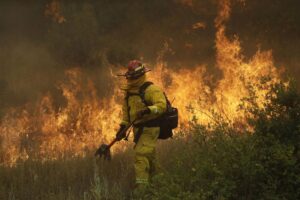
The National Weather Service issues, and cancels, fire weather watches (FWW), and red flag warnings (RFW) in coordination with the Wisconsin Department of Natural Resources and the U.S. Forest Service.
The weather service will not issue official warnings until certain threshold values, called red flag criteria, are forecast to occur. Red flag criteria differ from state to state. They usually include relative humidity values of 20% or less, winds of 20 mph or higher, and dry fuel conditions. Red Flag Warnings are usually only issued during the spring and fall fire weather seasons.
A Fire Weather Watch is issued 24 to 48 hours before the onset of red flag criteria. A Red Flag Warning is issued when red flag criteria are already occurring or will occur within the next 24 hours. The weather conditions under a Red Flag Warning may lead to especially dangerous wildfire growth. The warning alerts fire managers on federal and state lands that conditions are highly unfavorable for prescribed burns. Outdoor burning bans may be proclaimed by local law and fire agencies based on Red Flag Warnings.
The weather service will deploy specially trained forecasters to locations where large wildfires are active. These incident meteorologists, or IMETs, provide on-site weather support, including weather monitoring and daily fire weather briefings, to the command staff, firefighters and other incident personnel. Other atmospheric conditions can determine the danger of fire spread. For example, if the atmosphere is unstable, vertical movement of air tends to increase fire activity.
Steve Ackerman and Jonathan Martin, professors in the UW-Madison department of atmospheric and oceanic sciences, are guests on WHA radio (970 AM) at 11:45 a.m. the last Monday of each month. Send them your questions at stevea@ssec.wisc.edu or jemarti1@wisc.edu.

